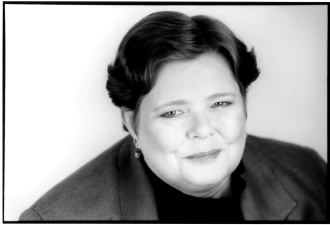Tamora Pierce is the New York Times Bestelling author of the Tortall series (which to date spans sixteen volumes), and Magic Circle series (ten, so far). She is also one of the few authors that sends me running to the bookstore to buy her latest hardcover on the first day of release, no questions asked. And the first picture below – that old, old version of Alanna’s cover – that’s the one I’ve had since I was eight. It still resides on my shelf to this day, a battered, beloved, and scotch taped testament to Tamora Pierce’s enduring appeal.
Byrt: You’ve said that you started writing to create the type of stories you like to read – what books did you read, growing up, that had a formative influence on you? What authors made you fall in love with fantasy?
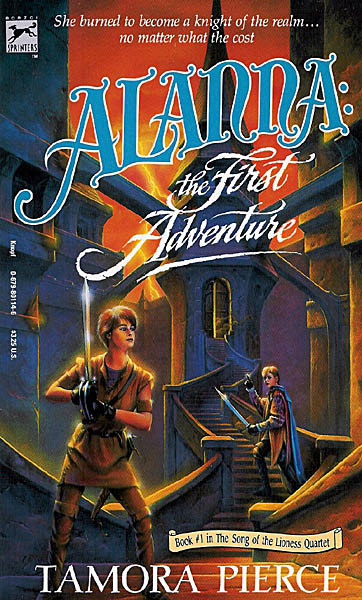 Tamora: It’s so hard to give a short answer for this! Mark Twain and Louisa May Alcott were some of my first remembered favorites. I started my lifelong adoration of Twain with Tom Sawyer and The Prince and the Pauper, and I think I read nearly everything Louisa May Alcott wrote for girls, my favorites being Little Women (I think every American woman writer secretly wants to be Jo March), Little Men, Eight Cousins, and Under The Lilacs. Most of my favorites throughout grade school were the kind of adventure books that were thought in those days to appeal more to boys: I read a lot of Edgar Rice Burroughs’ books, though more of his Mars and Pellucidar books than the ones he wrote about Tarzan. I loved Howard Pyle’s A Boy’s Tales of Robin Hood and His Merry Men and A Boy’s King Arthur and The Knights of the Round Table, and Robert Louis Stevenson’s Treasure Island. I also loved Greek and Egyptian myths, and The Iliad and The Odyssey. And I have to bow to Tolkein, Robert Howard, and Michael Moorcock, because they were the first official “fantasy” authors I read, starting in seventh grade, and they shaped the way I write fantasy and what I look for in fantasy.
Tamora: It’s so hard to give a short answer for this! Mark Twain and Louisa May Alcott were some of my first remembered favorites. I started my lifelong adoration of Twain with Tom Sawyer and The Prince and the Pauper, and I think I read nearly everything Louisa May Alcott wrote for girls, my favorites being Little Women (I think every American woman writer secretly wants to be Jo March), Little Men, Eight Cousins, and Under The Lilacs. Most of my favorites throughout grade school were the kind of adventure books that were thought in those days to appeal more to boys: I read a lot of Edgar Rice Burroughs’ books, though more of his Mars and Pellucidar books than the ones he wrote about Tarzan. I loved Howard Pyle’s A Boy’s Tales of Robin Hood and His Merry Men and A Boy’s King Arthur and The Knights of the Round Table, and Robert Louis Stevenson’s Treasure Island. I also loved Greek and Egyptian myths, and The Iliad and The Odyssey. And I have to bow to Tolkein, Robert Howard, and Michael Moorcock, because they were the first official “fantasy” authors I read, starting in seventh grade, and they shaped the way I write fantasy and what I look for in fantasy.
Byrt: Is today’s YA market more welcoming to fantasy than it was when you started, or less?
 Tamora: Fantasy has always been a solid part of Intermediate reading and YA. That said, the success of the Harry Potter books has created a golden age for fantasy as publishers opened up their lists not just to school-fantasy, but to any kind of fantasy authors could have come up with. We’ve seen incredible, unusual fantasy published since the mid-1990s: D.M. Cornish’s Monsterblood Tattoo trilogy, Suzanne Collins Hunger Games trilogy, Kristin Cashore’s work, Alison Goodman’s EON, Diana Peterfreund’s Rampant and its sequel, Scott Westerfeld’s steampunk Leviathan and its sequel—I could go on forever. Writers like Diana Wynne Jones, Jane Yolen, Garth Nix, Philip Pullman, Lloyd Alexander, and Laurence Yep were already well established before Potter, but the expansion in both page length and in what people were willing to read has produced wonderful writing from everyone.
Tamora: Fantasy has always been a solid part of Intermediate reading and YA. That said, the success of the Harry Potter books has created a golden age for fantasy as publishers opened up their lists not just to school-fantasy, but to any kind of fantasy authors could have come up with. We’ve seen incredible, unusual fantasy published since the mid-1990s: D.M. Cornish’s Monsterblood Tattoo trilogy, Suzanne Collins Hunger Games trilogy, Kristin Cashore’s work, Alison Goodman’s EON, Diana Peterfreund’s Rampant and its sequel, Scott Westerfeld’s steampunk Leviathan and its sequel—I could go on forever. Writers like Diana Wynne Jones, Jane Yolen, Garth Nix, Philip Pullman, Lloyd Alexander, and Laurence Yep were already well established before Potter, but the expansion in both page length and in what people were willing to read has produced wonderful writing from everyone.
Byrt: And do you have any pet peeves regarding the current trends in YA?
Tamora: I’ve seen some wonderful stuff from writers like Holly Black, Maggie Stiefvater, P.C. Cast, and Rachel Caine, but I do wonder how much longer the reign of (un)dead people, weres, and angels will go on in teen fiction. I do understand it’s an explanation of love, eternity, and the nature of evil and courage, but there’s an awful lot of it out there right now, and the books that don’t follow this trend seem to follow the shallow wicked wealthy people trend. To be fair, I’m neither a romance fan nor a decadent rich fan in adult reading, so I have baggage. And I had my vampire phase back in my 20s and 30s, so I’m all vampired out.
Byrt: You’ve mentioned that you used to review martial arts movies – what are your all time favorites?
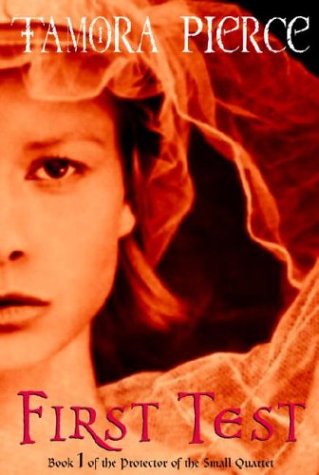 Tamora: Jackie Chan’s The Big Brawl, set (sorta) in the 1930s; Bruce Lee’s Enter the Dragon and Return of the Dragon, Sonny Chiba’s Streetfighter and Etsuko Shiomi and Sonny Chiba’s Sister Streetfighter, Kathy Long’s The Stranger (seldom seen, makes my heart sing). I also watch movies to see Wesley Snipes’ martial arts work (bad Wesley for getting yourself in jail over taxes!). And I used to adore Chuck Norris’s movies, but the Chuck Norris of recent years has ruined them for me. I can’t even watch Dodgeball anymore with that moment at the end when he appears.
Tamora: Jackie Chan’s The Big Brawl, set (sorta) in the 1930s; Bruce Lee’s Enter the Dragon and Return of the Dragon, Sonny Chiba’s Streetfighter and Etsuko Shiomi and Sonny Chiba’s Sister Streetfighter, Kathy Long’s The Stranger (seldom seen, makes my heart sing). I also watch movies to see Wesley Snipes’ martial arts work (bad Wesley for getting yourself in jail over taxes!). And I used to adore Chuck Norris’s movies, but the Chuck Norris of recent years has ruined them for me. I can’t even watch Dodgeball anymore with that moment at the end when he appears.
Byrt: And do you still keep up with the latest releases? (Have you seen Jeeja Yanin, Rina Takeda and/or David Belle in action?)
Tamora: As you may have guessed, no, though I have watched some Tony Jaa and, of course, Jet Li. I am a purist, and if I can’t tell if the person is any good because the fights are all cut together and sped up to a fare-thee-well, I’m not interested. I enjoyed parts of Crouching Tiger, Hidden Dragon, but I wasn’t sure of the realism of the sword, and I hate wire work! I like to see if a fighter is actually good all on his or her own.
Byrt: How do you go about choreographing the fight scenes in your books? Does your inspiration come from research, or your martial arts background? Do you ever swing a sword or baton around to get it just right?
 Tamora: I started by picking apart fight scenes in what were called “sword and sandal movies” and swashbuckler movies when I was a kid, when they had these things on afternoon television all of the time. I’d watch for how people moved and how they blocked. Then I saw the Richard Lester-directed Three Musketeers and Four Musketeers, which was the first time I felt I was watching real street fights, with the fighters using anything at hand. Not long after that I was introduced to martial arts movies, which I watched intently, over and over, again, picking the moves of both parties apart, and still more historical movies. And I discovered samurai movies, and both samurai battles and iaido, the art of the fast draw.
Tamora: I started by picking apart fight scenes in what were called “sword and sandal movies” and swashbuckler movies when I was a kid, when they had these things on afternoon television all of the time. I’d watch for how people moved and how they blocked. Then I saw the Richard Lester-directed Three Musketeers and Four Musketeers, which was the first time I felt I was watching real street fights, with the fighters using anything at hand. Not long after that I was introduced to martial arts movies, which I watched intently, over and over, again, picking the moves of both parties apart, and still more historical movies. And I discovered samurai movies, and both samurai battles and iaido, the art of the fast draw.
I took tae kwon do karate for a year before I tore my tendon, but I continued to visit classes. I also sat in on kendo and judo classes when my friends were shopping for a school, and a fencing class when a friend who’d been a coach got me in. I worked with a black belt before I took karate who taught me about balance, blocks, and punches, and I practiced those.
I also wrote and directed a martial arts movie for a friends’ student film, which is where I learned the joys of choreographing martial arts.
Take all of that, and add to it all of my hand weapons, including several kinds of sword and a real naginata. I know the strength and skill it takes simply to draw a samurai sword flawlessly and hold it outstretched without shaking. (I’m not good at it. That sucker is heavier than it looks, and I haven’t built my wrists and arms up!)
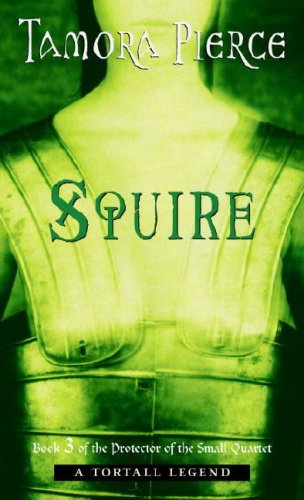 And then I start to write. I picture the fight in my head, each move by each fighter. I can’t just forget the other fighters while my hero is moving. Bad guys don’t wait for you to finish, contrary to the movies. They don’t come at you one at a time. You have to have eyes in the back of your head, and know what the guy on your side is doing as well as the one you’re actively engaged with. I’ll rewrite a fight scene, movement by movement, character by character, five or six times per draft just so I don’t get the letter that says, “You had this, and this, but this is in the way, and you forgot so-and-so was there, and that just can’t happen!” Sometimes I’ll use an actual piece from a fight I saw, like Alanna’s butterfly cut, but you also have to take in the characters. Alanna would never pick up a bench and charge a line of bad guys, but Tunstall would. Esmond and Owen would never think of getting into a corner so they can limit the ways in which the bad guys come at them, because they lose their heads a bit, but Kel and Beka would, and Kel would drag her friends with her.
And then I start to write. I picture the fight in my head, each move by each fighter. I can’t just forget the other fighters while my hero is moving. Bad guys don’t wait for you to finish, contrary to the movies. They don’t come at you one at a time. You have to have eyes in the back of your head, and know what the guy on your side is doing as well as the one you’re actively engaged with. I’ll rewrite a fight scene, movement by movement, character by character, five or six times per draft just so I don’t get the letter that says, “You had this, and this, but this is in the way, and you forgot so-and-so was there, and that just can’t happen!” Sometimes I’ll use an actual piece from a fight I saw, like Alanna’s butterfly cut, but you also have to take in the characters. Alanna would never pick up a bench and charge a line of bad guys, but Tunstall would. Esmond and Owen would never think of getting into a corner so they can limit the ways in which the bad guys come at them, because they lose their heads a bit, but Kel and Beka would, and Kel would drag her friends with her.
Byrt: In your stories, you drawn inspiration from different parts of the world – i.e. Scandinavia (Scanra), Japan (Yamani), Indonesia (Copper Isles), and Carthage (Carthak). Are there any particular places or times you have in mind for the future? Or is there a place you’d like to revisit?
Tamora: At the moment I’m researching China in 1200 or so and Tibet at the same time for the next Circle book, and Meteora in Greece (the landscape and monasteries) for the book in which Tris goes to Lightsbridge. I’ll be returning to Carthak, and going on from there to Tyra and southern Tortall, in Numair’s books, and going back to the Isles at some point to re-visit the rebellion, Dove, and Aly and Nawat’s future in the Isles. Beyond that, who can say? I’ve always got ideas cooking in the back of my head!
Byrt: There is a recurring theme in your books, of animals that both help and hinder your heroes. Have any of them been based on pets you’ve had or known? Or wild animals you’ve tried to help (and gotten scratched or bitten for your pains)?
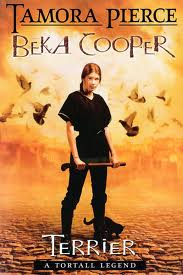 Tamora: I based Faithful on my college cat Fido, who approved the pages he liked of the original Song of the Lioness manuscript by sitting and shedding on them. My current black cat, Scooter, has been standing in for Pounce, and like Fido, gives me plenty of advice on how I should proceed. The problem is that I couldn’t understand Fido and I can’t understand Scoot, since I don’t speak cat. ::sigh::
Tamora: I based Faithful on my college cat Fido, who approved the pages he liked of the original Song of the Lioness manuscript by sitting and shedding on them. My current black cat, Scooter, has been standing in for Pounce, and like Fido, gives me plenty of advice on how I should proceed. The problem is that I couldn’t understand Fido and I can’t understand Scoot, since I don’t speak cat. ::sigh::
Scooter did get to give away his older “brothers,” PeeWee and Gremlin, to Kora and Aniki in Terrier, which made him very smug for about a week. One of our other cats who has passed on, Ferret, has appeared as Mystery in Street Magic and the unnamed orange and gray cat in Lady Knight. Kel’s original sparrow friends, Nari, Arrow, Freckle, and Crown, Flick the squirrel in Wolf Speaker, and Slapper and the other named pigeons of Terrier, are all friends of mine from Riverside Park whom I fed regularly while I lived nearby. (Slapper was actually “Gloucester” after Richard III, for his clubbed foot, humped back, and crazed eyes, but I couldn’t use his real name, so I called him after his habit of smacking me before and after I fed him.) Kel’s griffin is based on my best friend’s pet dove, found and rescued in Washington Square Park, while the dragons Scamp and Grizzle are her toy poodle and Maltese, and Little Bear and Achoo are two later dogs of hers. (Pidge, the dove, was my presentation of the joys of rescuing wildlife.) I see no reason why animals who are my friends can’t be in my books.
Byrt: I love the moral shades of gray in Beka Cooper’s world, where even honest cops accept bribes – are the crooked ways of the Lower City based on any particular time or place in history?
 Tamora: Just the medieval world in general. It’s still this way in Alanna’s time, and in our world it’s this way in 2/3s of the world. It’s only been in the last 60 years or so that bribery has been illegal—and prosecuted. And prosecution for crimes among and against the poor is still pretty durn slipshod. I realize it’s not glamour law enforcement, but how can people trust in their government when their government doesn’t do anything good for them?
Tamora: Just the medieval world in general. It’s still this way in Alanna’s time, and in our world it’s this way in 2/3s of the world. It’s only been in the last 60 years or so that bribery has been illegal—and prosecuted. And prosecution for crimes among and against the poor is still pretty durn slipshod. I realize it’s not glamour law enforcement, but how can people trust in their government when their government doesn’t do anything good for them?
Byrt: Your next Tortall series is set to be the early years of Numair, but do you think you’ll ever return to the years between Beka and Alanna? Will we ever see what brought about the end of slavery in Tortall?
Tamora: Dunno to the first; we’ll see to the second. ;-)
Byrt: Do you think Beka and Kel would have been friends, if they were contemporaries?
Tamora: I don’t know. Beka has class issues. On the other hand, Kel is one of those rare knights who wants everyone to have equal treatment under the law, so they might get on very well once Beka realized that Kel means it. Kel tends to wait to accept people until she sees who they really are, so she would be reserved with Beka until she realized Beka was one of the good ones. Then they might spend long hours talking about how the law might be changed.
Byrt: Can you tease a little bit about what’s coming up next for Beka in Mastiff?
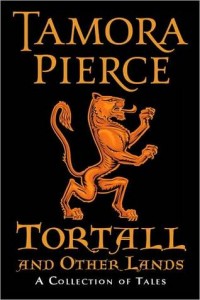 Tamora: In Mastiff, Beka and her partner Tunstall are put on the biggest case of their lives. Traveling along with Pounce, Achoo, a mage named Farmer, and Lady Sabine (there to deal with nobles), they are on the trail of kidnapping evil-doers who murder anyone that gets in their way—or possesses even the slightest tidbit of information about them or their organization. Murder and treason are afoot at the highest echelons of the realm. Beka will be dealing with greedy nobles, a rising religious cult, and a hunt throughout the kingdom that will either make her career, or end her life.
Tamora: In Mastiff, Beka and her partner Tunstall are put on the biggest case of their lives. Traveling along with Pounce, Achoo, a mage named Farmer, and Lady Sabine (there to deal with nobles), they are on the trail of kidnapping evil-doers who murder anyone that gets in their way—or possesses even the slightest tidbit of information about them or their organization. Murder and treason are afoot at the highest echelons of the realm. Beka will be dealing with greedy nobles, a rising religious cult, and a hunt throughout the kingdom that will either make her career, or end her life.
Byrt: And what other projects are you working on right now?
Tamora: I have a short story collection coming out in February, Tortall. Most of the stories are set in Tortall, including two of the new ones (all but three are previously published, but most people won’t have seen them before), and one is based on my time as a housemother in a group home (non-fantasy).
Next up to write is Briar, Rosethorn, and Evvy and the Yanjing war on Gyongxi, home of the first temple of the Living Circle faith. It’s when Evvy meets Luvo, and where all three incur the post-traumatic stress disorder mentioned in Melting Stones and Will of the Empress.
Byrt: Do you think there will ever be another Circle of Magic book with Briar, Tris, Daja and Sandy all together again?
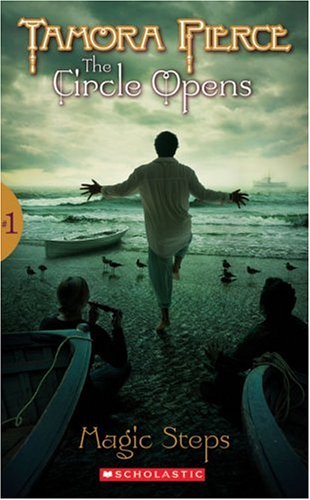 Tamora: As for more Circle books: YES! There will be many more to come. At the moment I have plans for at least four new Circle stories beyond the two you can see listed on my website. After I’ve completed those two, I want to write about Pasco doing something on his own, one about Kethlun, one about either Nia or Jory (I haven’t decided which yet), and eventually a book about the young Niko and the young Gorse. At this point I’m really not sure if I will have the original gang all together again for one book. But I never say never!
Tamora: As for more Circle books: YES! There will be many more to come. At the moment I have plans for at least four new Circle stories beyond the two you can see listed on my website. After I’ve completed those two, I want to write about Pasco doing something on his own, one about Kethlun, one about either Nia or Jory (I haven’t decided which yet), and eventually a book about the young Niko and the young Gorse. At this point I’m really not sure if I will have the original gang all together again for one book. But I never say never!
Byrt: You’ve mentioned once or twice the impressive breadth of your profane vocabulary – was there any particular time or place in your life from which you acquired your legendary skills? :)
Tamora: No, I just started from my parents’ novels when I was in grade school, continued when I learned that foreign languages had these useful words, added the gestures I could glean here and there, and began to pick up linking contemporary and archaic words into chains of pure vilification, purely to relieve my feelings. If I’m concentrating on picking the next vile word, I discovered, I’m not blowing a fuse. Also, it’s fun to hear people’s voices crack and see them turn funny colors.
Byrt: And lastly, I love the list of books and TV you have on your website – have you read or watched anything recently that has earned a spot on a future list?
Tamora: I think Tim is working on putting my newest TV and movie lists on my website, and I’m working on my 2010 favorites list. I forgot Leverage and Justified on my TV list, and I really, really can’t wait for George R. R. Martin’s Song of Ice and Fire on HBO!!
Thanks again to Tamora for stopping by the Bookyurt!
For more on all things Tamora, you can find her website here.
